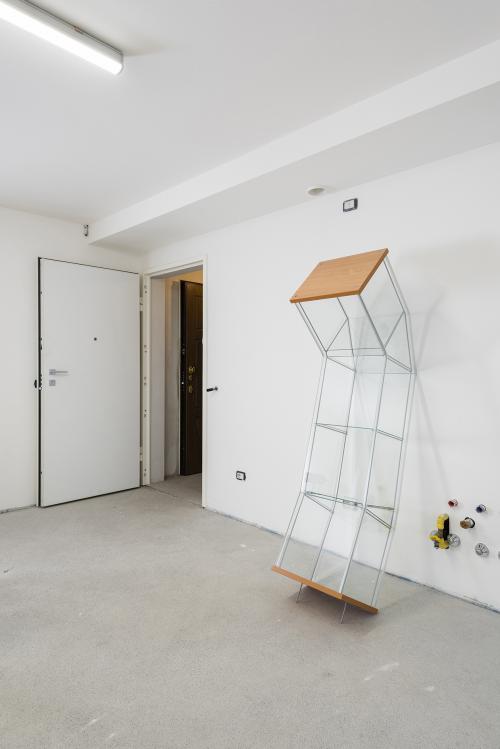Yael Frank

1/4
Yael Frank – The Last Hour of Cabinet I – 2018 – manipulated Ikea Detolf cabinets – variable dimensions – With support by Artis, The Ostrovsky Family Fund, The Rabinovitch Fund, and the Pais Institute in Culture
So funny you could cry - On Echoes of Death in the work of Yael Frank
Central to her artistic practice, Yael Frank deploys humor as strategic means for subverting conventions, regardless of genre of medium. Travesty and comedy are ways for her to expose and undermine received notions and power mechanisms that are written into the fabric of thought and society, divesting them from their vested authority while suggesting other, unexpected alternatives of considering enduring issues and complexities. The cathartic release associated with humor thus offers an escape from entrenched ideologies, foregrounding in- stead the underlayers of a discourse that often remain inaccessible and silenced.
In the exhibition The Uncanny Valley, Frank juxtaposes two recent works of hers, both ambitious in scale: A Problem, a video which animates three sets of dental jaw models engaged in an existential conversation, and The Last Hour of Cabinet I, a large-scale sculptural arrangement composed from Ikea cabinets rearranged as a devotional tableau vivant. While autonomous, the two works combine to spawn an environment that is disturbing, morbid and parodic, where inanimate objects come to life. The overall spectacle relates to the ‘death problem’ – the haunting fact of the demise that awaits us, the most fateful eventuality in a person’s life and its only unshakable certainty.
After it has been secularized and cleansed of spiritual, ritualistic or metaphysical connotations, death has become, in modern societies, an unspeakable taboo, a private event that has no place in public life. And yet, death is a constant in the cultural baggage we carry, forever resurfacing in the undying pathos of religious representations as in the imagery and vocabulary of pop culture; in the existential helplessness of the Theater of the Absurd as in the loss of a sense of self in digital culture.
Frank, who delivers a satirical and anti-heroic feat with regard to this hopeless problem, would rather look this meaninglessness straight in the eye, to strip death of the veils of loss and pathos that still shroud it, being as it is the product politicization. Turning death into a hackneyed, bothersome joke, she draws inspiration from a variety of sources, from Christian iconography and the plays of Brecht and Beckett to reality TV, animated cartoons and talk shows – blending ‘high’ and ‘low’ into an absurd display that tries to decipher the death phenomenon in our culture.
With A Problem, she brings us something of a muppet show raised from the dead. Created in stop-motion technique, the work animates its three dental-appliance protagonists from their place on a glass cabinet in a shop for dental supplies. Projected on to the wall, they assume gigantic proportions, observing from up high the sculptural complex laid out below them. As a trio of dark oracles, their verbose, authoritative voices echo throughout the exhibition, delivering a pompous yet empty text, a sequence of clichés that could have been pieced together from any number of existing sources. The text they deliver revolves around some unnamed socio-political problem, using a hollow rhetoric meant to engage listeners and call them into action. Despite the uncompromising and resolute tone, the text is in fact hyperbolic, pointing to its own inherent absurdity.
Across from it is a heart-rending yet minimalist-looking sculptural installation, The Last Hour of Cabinet I. Constructed entirely from Ikea ‘Detolf’ glass cabinets, the artist has subjected these to a range of manipulations – dismantling, bending, re-assembling and soldiering – to recre- ate them in the image of a pathos-filled scene at the height of its drama: family members and friends surrounding their loved one in his final hour. The multi-participant composition is modeled on the Dormition iconography in Eastern Christianity (the virgin Mary on her deathbed), but with a mechanic redundancy that strips it of its sacred pathos. Not only is a mass-produced, highly ubiquitous object being personified to represent a family in its charged moment of pain and grieving, this personification is directed at a momentous religious symbol of universal gravitas.
While completing each other, the two works differ greatly in tone, with The Last Hour of Cabinet I appealing to our emotions, as A Problem, with its intellectualized reasoning, appeals to our logic and judgment. The space that unfolds between the two is hence an interpretative one, leaving the viewer with the freedom to decide what preceded what: Did the political crisis narrated by the jaws lead to the unique tragedy of the sculptural complex, or is it the other way around, with the mythic and universal codification of the mortuary scene lying at the root of the unending succession of humanitarian catastrophes that define humanity from its very beginnings? Either way – and despite the satirical presentation – each of them manages to validate its own narrative, absurd as it may be.
yaelfrank.net

1/4
Yael Frank – The Last Hour of Cabinet I – 2018 – manipulated Ikea Detolf cabinets – variable dimensions – With support by Artis, The Ostrovsky Family Fund, The Rabinovitch Fund, and the Pais Institute in Culture


